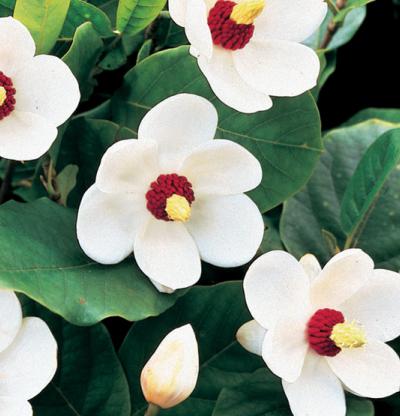





 Oyama magnolia (Magnolia sieboldii)
mag-NO-lee-ah see-BOLD-ee-eye
Synonyms:
M. parviflora
Genus:
Magnolia
This spreading, deciduous shrub grows 15 to 25 feet tall and blooms in late spring to late summer, with white fragrant blossoms. Site where the slightly nodding flowers with rich rose-red stamens can be seen from below.
Care:
Grow in moist, well-drained, preferably acidic to neutral soil in sun or partial shade; magnolias do not tolerate wet feet. Magnolia flowerbuds are susceptible to late-season frosts; shelter large-leaved species from windy locations. Prune trees and deciduous shrubs in late winter or late summer to prevent bleeding of sap; prune minimally to maintain a healthy framework. In warmer climates, this species prefers partial shade with a cool root zone.
Propagation:
Sow seeds in autumn or stratify to hasten germination. Root softwood cuttings in early summer. Magnolias can be layered in early spring, grafted in winter, and propagated by bud in summer.
Problems:
Bacterial leaf spot, spot anthracnose, canker, dieback, butt rot, powdery mildew, anthracnose, fungal spots, weevils, snails, scale insects, thrips, planthoppers
Oyama magnolia (Magnolia sieboldii)
mag-NO-lee-ah see-BOLD-ee-eye
Synonyms:
M. parviflora
Genus:
Magnolia
This spreading, deciduous shrub grows 15 to 25 feet tall and blooms in late spring to late summer, with white fragrant blossoms. Site where the slightly nodding flowers with rich rose-red stamens can be seen from below.
Care:
Grow in moist, well-drained, preferably acidic to neutral soil in sun or partial shade; magnolias do not tolerate wet feet. Magnolia flowerbuds are susceptible to late-season frosts; shelter large-leaved species from windy locations. Prune trees and deciduous shrubs in late winter or late summer to prevent bleeding of sap; prune minimally to maintain a healthy framework. In warmer climates, this species prefers partial shade with a cool root zone.
Propagation:
Sow seeds in autumn or stratify to hasten germination. Root softwood cuttings in early summer. Magnolias can be layered in early spring, grafted in winter, and propagated by bud in summer.
Problems:
Bacterial leaf spot, spot anthracnose, canker, dieback, butt rot, powdery mildew, anthracnose, fungal spots, weevils, snails, scale insects, thrips, planthoppers
Copyright © www.100flowers.win Botanic Garden All Rights Reserved